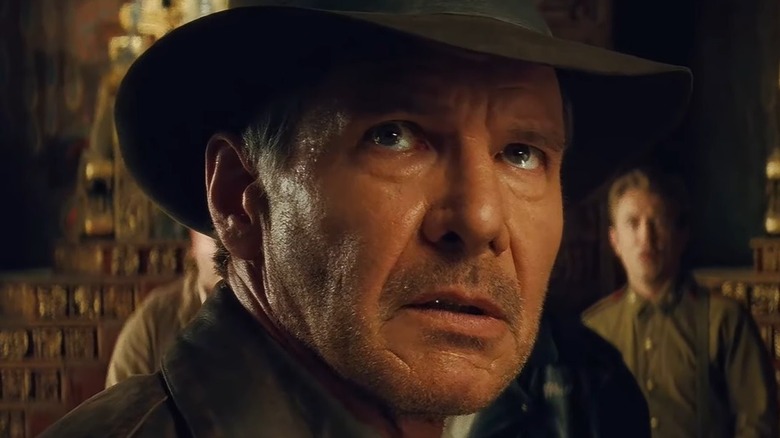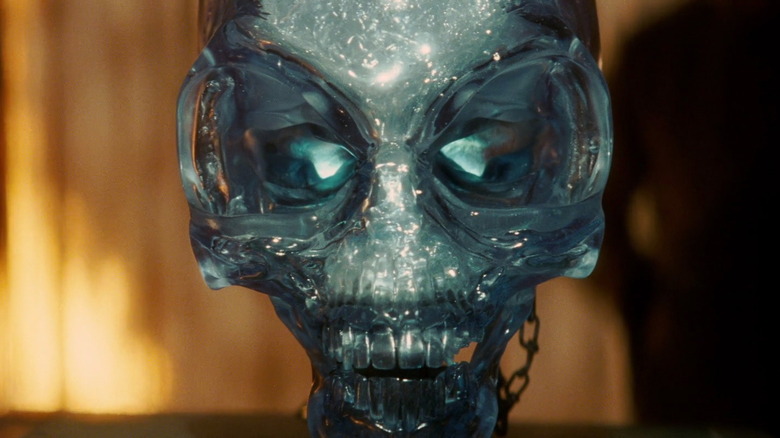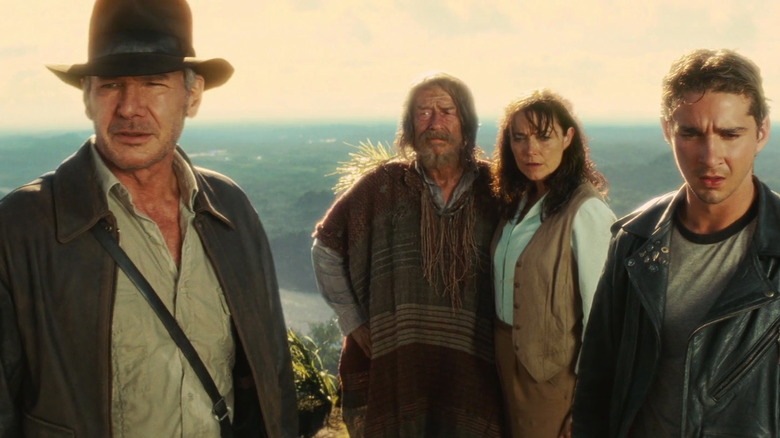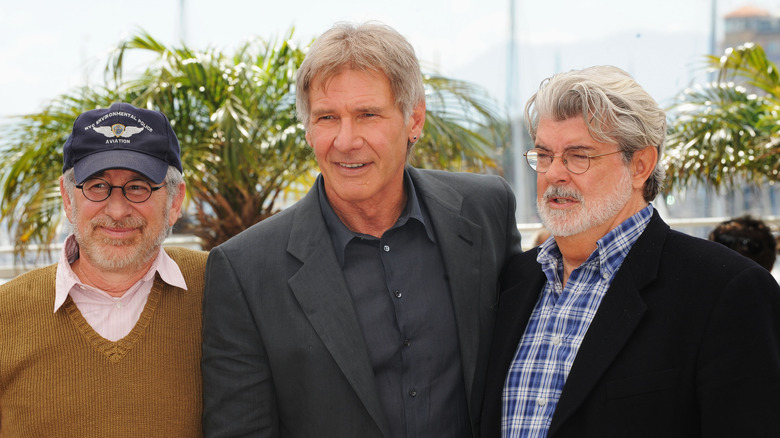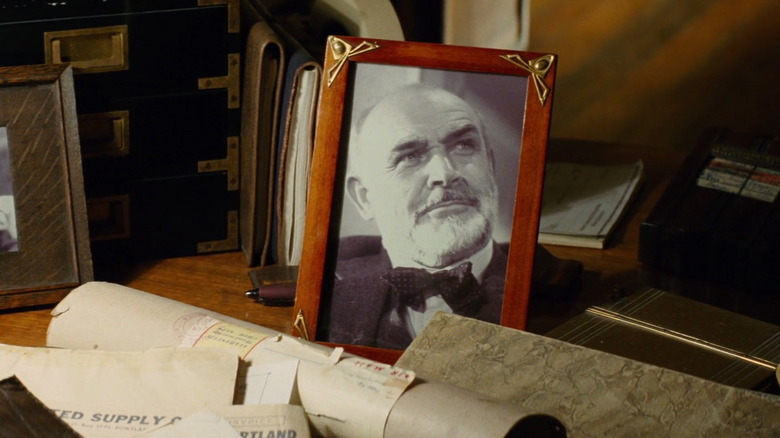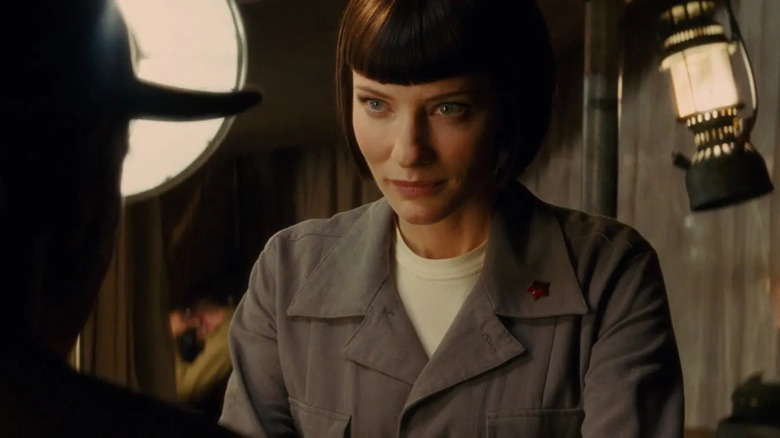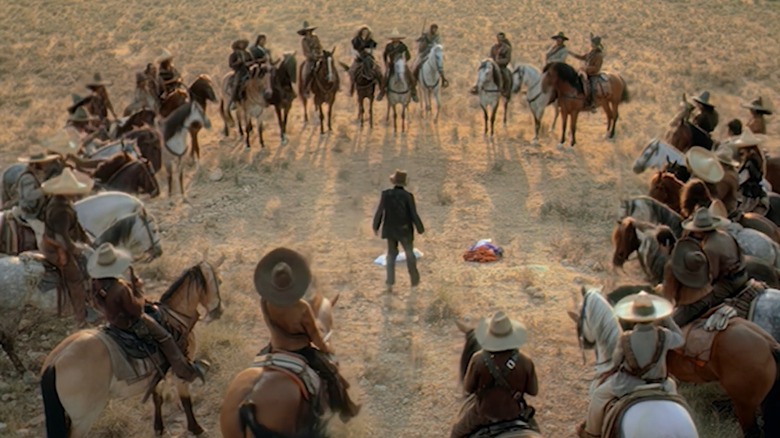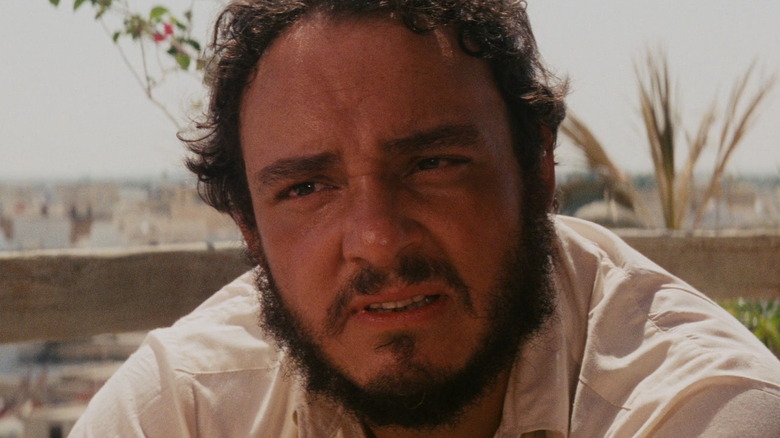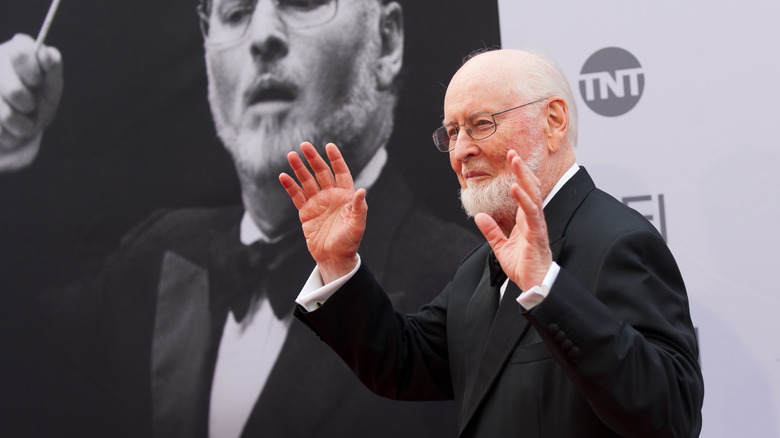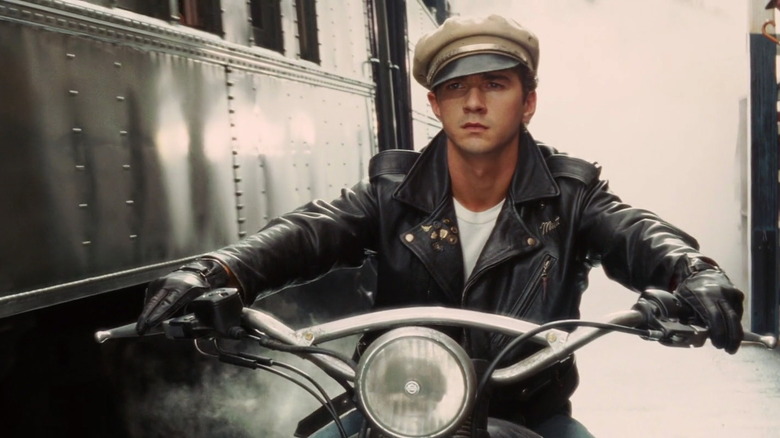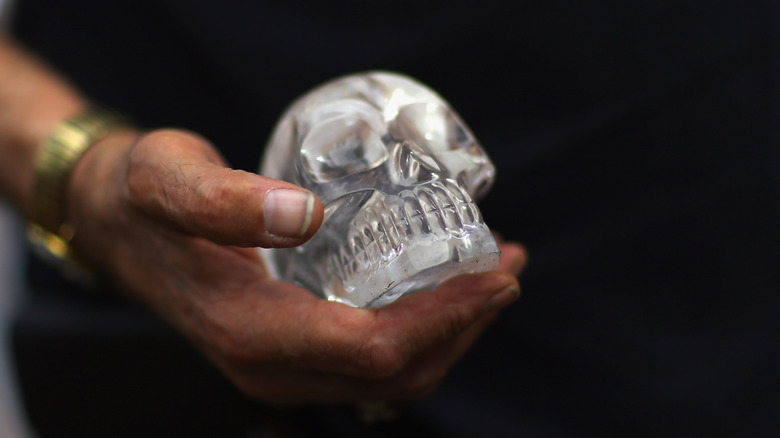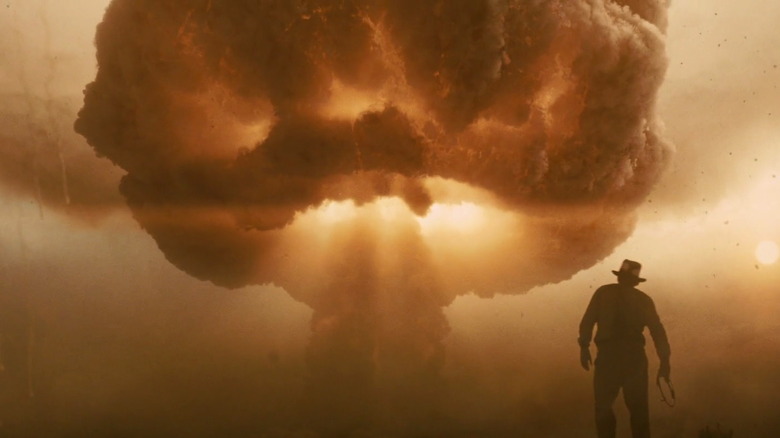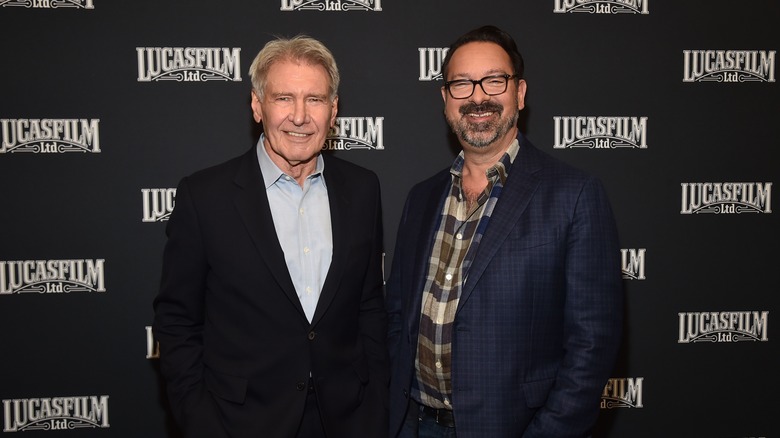Action-Packed Facts About The Kingdom Of The Crystal Skull That Indy Fans Will Love
In 2008, Steven Spielberg and George Lucas brought one of Hollywood's most iconic characters back to the silver screen. "Indiana Jones and the Kingdom of the Crystal Skull" hit theaters that summer and, despite a solid critical reception and a strong box office performance, almost immediately went down in history as a shining example of how not to do a sequel.
There's certainly a lot not to love about "Kingdom of the Crystal Skull." The crystal skulls in question don't capture the imagination quite as much as, say, the Ark of the Covenant or the Holy Grail. There's a whole heap of unnecessary CGI. Shia LaBeouf's Mutt is a total misfire. All in all, the movie's sillier scenes feel like a step too far even for Indy. You know what we mean.
It's not all bad, though, and among the better aspects of "Crystal Skull" — its charming '50s setting, Harrison Ford's performance, the superb villains — is the simple fact that no movie franchise does adventure quite like "Indiana Jones." So pick up your fedora, crack that whip, and get ready to believe the impossible: There's more to "Indiana Jones and the Kingdom of the Crystal Skull" than meets the eye.
The search for the MacGuffin
The MacGuffin is the heart of every "Indiana Jones" movie. A term first named by Alfred Hitchcock (per Merriam-Webster), a MacGuffin is an item, a character, or an event in a movie that propels the narrative and drives the lead characters' motivations. In "Raiders of the Lost Ark," it's the Ark of the Covenant; in "Temple of Doom," it's the Sankara Stones; in "The Last Crusade," it's the Holy Grail.
In 2008, Vanity Fair published an article detailing the development of "Kingdom of the Crystal Skull," which had been discussed intermittently since shortly after 1989's "Last Crusade." Perhaps unsurprisingly, the first problem Spielberg and Lucas had to overcome as they devised their fourth "Indiana Jones" movie was the nature of the MacGuffin. Lucas came up with the idea of the crystal skull in the early '90s, during a shoot with Harrison Ford on the "Young Indiana Jones" TV series.
Unfortunately, neither Spielberg nor Ford were convinced. Lucas ignored them, however, and hired multiple screenwriters to work the crystal skull into an "Indiana Jones" script. Only after 15 years — and the intrusion of the "Star Wars" prequels — did he finally ease off. Then, when Ford voiced his interest in starring in a new "Indy" movie, Lucas brought it all back. "He's a stubborn sucker," Ford told Vanity Fair, "and he had an idea that he kept pushing into script form, and then they'd run it by me, and I'd usually rebel, and, finally, you know, one script came along that really struck me as being smart ... so I said, 'Let's go, let's make this one.'"
Indiana Jones and the City of Gods
Arguably the most famous of the early "Crystal Skull" drafts commissioned by Lucas is "Indiana Jones and the City of Gods," written by Frank Darabont. Best known as the screenwriter behind "A Nightmare on Elm Street 3: Dream Warriors" and director of "The Shawshank Redemption" and "The Green Mile," Darabont's "Indy" script made headlines when it leaked online in 2008 (via MTV).
Many similarities exist between "City of Gods" and "Kingdom of the Crystal Skull." The story follows Indiana through the jungles of South America as he hunts down the legendary crystal skulls. Marion Ravenwood makes her triumphant return, the flesh-eating ants get their moment in the spotlight, and Indy even climbs into a fridge to survive a nuclear explosion. But there are a number of differences, too. For one thing, Shia LaBeouf's character, Mutt, doesn't exist, while Marion's characterization is more in line with "Raiders of the Lost Ark."
The climax of the movie more heavily involves the protagonist, too — rather than simply standing by and watching the villain detonate her own head with alien knowledge, Indy is taken into a "dream cloud" by the power of the skull and offered anything he desires. The choice he makes could easily have resulted in one of the all-time great "Indiana Jones" moments. And yes, in case you're wondering, the script itself is still out there. If nothing else, it provides a fascinating insight into what might have been for Indy's fourth adventure.
Robbing the grave
"Kingdom of the Crystal Skull" was released 19 years after "The Last Crusade," which meant that, going into production, Lucas, Spielberg, and the 66-year old Ford were forced to deal with an inescapable truth: Indiana Jones was getting old.
There were any number of ways they could have dealt with this issue, but the simplest turned out to be the best. Firstly, they set the movie 19 years after the events of "Last Crusade," meaning Indiana is exactly as old as Ford was when they filmed it. Secondly, they allowed the story to fully lean into the hero's age: Indy makes occasional misjudgments and struggles through action scenes, for example, and laments that his life "isn't as easy as it used to be." At one point, Mutt straight up asks him if he's 80.
As it turns out, this was a huge part of the film's appeal to Ford. "That's one of the things I was most keen about," he told Entertainment Weekly in 2008. "Just acknowledge the years, without reservation. What's the big deal? The guy's 18, 20 years older. So what?" Ford even had a last word for the fans who were worried about his character's age. "Yeah, I've heard it," he said. "'Aaaaw, he's older.' Well, s***, yes. And by the way? So are you ... Take a look in the f****** mirror!"
The death of Henry Jones, Sr.
Of course, "Kingdom of the Crystal Skull" wasn't the first time the "Indiana Jones" franchise had brought an old man along for an adventure. "Indiana Jones and the Last Crusade" starred Sean Connery as Henry Jones, Sr., Indy's grouchy, Grail-obsessed father. The relationship between Indy and his father gives "The Last Crusade" much of its heart, and Connery's eccentric performance and surprising knack for slapstick help make it by far the funniest of the "Indy" movies.
In "Crystal Skull," however, it's revealed that Henry died a couple of years before the events of the movie. This isn't a huge surprise, of course — Indy's dad must have been about 60 years old in "The Last Crusade," placing him at nearly 80 by the time of the fourth installment — but it wouldn't have been impossible to bring him in for a cameo. Sean Connery was around in 2008 too, albeit retired from acting. So what happened?
Well, in an interview conducted in 2007 (via The Hollywood Reporter), Connery explained that Spielberg did indeed try to bring him out of retirement for "Kingdom of the Crystal Skull." "I spoke with Spielberg," he said," but it didn't work out. It was not that generous a part ... and they had taken the story in a different line anyway, so the father of Indy was kind of really not that important."
Connery even claimed he gave Spielberg the idea to kill Henry off altogether. Best known for his roles in the James Bond franchise, "The Untouchables," "Highlander," and, of course, "Indiana Jones," the Oscar-winning Scottish actor died in 2020.
New foes
An "Indiana Jones" movie is only as good as its villains, and in that regard, "Kingdom of the Crystal Skull" had big shoes to fill. From Major Toht to Mola Ram to René Belloq, Indy's foes can easily be counted among cinema's most iconic baddies. Luckily, Spielberg and company more than pulled it off.
In 2007, news outlets reported that Cate Blanchett had been cast as a "nefarious foe, possibly in league with the Russians" (per Rotten Tomatoes). Irina Spalko is a Soviet scientist, KGB agent, and psychic who is sent to retrieve a crystal skull of Akator for the Russians, who hope to use its power to their advantage in the Cold War. She's creepy, ruthless, and obsessed with the pursuit of knowledge — what more could you want from an "Indy" villain?
According to the DVD documentary "The Making of 'The Kingdom of the Crystal Skull,'" Spalko was inspired by the Soviet pursuit of psychic warfare during the 1950s. Lucas found this angle far more interesting than returning to the Nazis yet again, and Spielberg felt uncomfortable depicting the Third Reich in a light-hearted manner after his experience directing "Schindler's List." It appears to have been the right thing to do; the Soviets are the perfect antagonists for the movie's '50s setting, and Spielberg even told EW in 2008 that Spalko is his favorite "Indiana Jones" villain.
A link to the past
"The Young Indiana Jones Chronicles" was a TV series that aired in the early '90s. It follows — you guessed it — a younger version of Indy as he embarks on a number of adventures around the world. It wasn't exactly a smash hit, and, with the exception of four made-for-television movies that followed a few years later, the series was canned in 1993.
Despite holding barely a fraction of the cultural sway of the "Indiana Jones" movies, "Chronicles" does get a shout-out in "Kingdom of the Crystal Skull." Early on in the story, Indy tells Mutt he once "rode with Pancho Villa," the legendary Mexican revolutionary. Sure enough, Villa appears in "Young Indiana Jones and the Curse of the Jackal," the TV show's pilot episode. In this story, Indy joins Villa's bandits as they raid territories across the American border. After becoming disillusioned with Villa's cause, however, Indy decides the revolution is not his to get involved in and slips away in the night. "Crystal Skull" only briefly alludes to this phase in Indy's life, but the reference will nevertheless have come as a pleasant surprise to fans of "The Young Indiana Jones Chronicles." All four of them.
Where's Sallah?
"Kingdom of the Crystal Skull" may have brought Indy's ex-flame Marion Ravenwood back to the "Indiana Jones" franchise, but the movie stopped short of a full "Raiders" reunion; Sallah Mohammed Faisel el-Kahir, played by John Rhys-Davies, was conspicuously absent from the cast list. Sallah had already returned once, in "The Last Crusade," so what kept him away from "Crystal Skull?"
In 2016, Rhys-Davies told Digital Spy that he had, in fact, been asked to appear in the fourth installment, but declined because he felt his part was too small. "I was asked to be in the last one," he said, "but they wanted me to do a bit of green-screen ... and they were going to cut that into the wedding scene at the end. I turned it down because it seemed to me that that would be a bit of a betrayal of the audience's expectations. Sallah is a popular character — there's a greatness of soul about him that we all love and admire."
Thankfully, Sallah fans won't have to wait much longer to see him again, as the character will be making his triumphant return in "Indiana Jones 5." It's clear that director James Mangold has given Rhys-Davies want he wants this time around, as Sallah could be heard delivering one of the foremost lines in a teaser trailer exclusively premiered at 2022's D23 convention (per Collider). "I miss the desert," Rhys-Davies' unmistakable voice intones. "I miss the sea, and I miss waking up every morning wondering what kind of adventure the new day will bring to us." Here's hoping "Indy 5" offers many more chances for Sallah to show off that undeniable "greatness of soul."
The maestro returns
If adventure has a name, it's Indiana Jones — but if adventure has a sound, it's the music of John Williams. Obviously, Williams' "Raiders March" is one of the most iconic film themes of all time, but each movie's score is rife with incredible music, from the "Ark Theme" and "The Temple of Doom" to the "Grail Theme" and the inimitable "Scherzo for Motorcycle and Orchestra."
So naturally, Williams returned for "Kingdom of the Crystal Skull." A year after the movie's release, Williams told Variety that he had been fascinated by the prospect of returning to the world of Indiana Jones. "The original was a generation ago," he said. "It's an interesting life experience to revisit and rework material that was written by a much younger version of ourselves. It's almost like sitting down and finishing a letter that you started 25 years ago."
Williams brought back some of the franchise's most famous motifs — the "Raiders March" and "Marion's Theme," of course, as well as the "Ark Theme" and the "Father and Son Theme" in brief cameos — but he also developed many more original pieces, such as "Irina's Theme" and "The Adventures of Mutt."
To the surprise of nobody, Williams' work will also be heard in "Indiana Jones 5," with the legendary composer debuting the first of the movie's new themes, "Helena's Theme," at the Hollywood Bowl in September 2022 (per Variety).
Ford vs. LaBeouf
You don't have to go far to find somebody who didn't like "Kingdom of the Crystal Skull" — and the cast is no exception.
In 2020, Shia LaBeouf attended the Cannes Film Festival — for the first time since he appeared there to promote "Crystal Skull" — and told reporters that he felt personally responsible for some of the issues that plagued the movie (per The Los Angeles Times). "I feel like I dropped the ball on the legacy that people loved and cherished," he explained. "You get to monkey-swinging and things like that and you can blame it on the writer and you can blame it on Steven. But the actor's job is to make it come alive and make it work, and I couldn't do it. So that's my fault. Simple." LaBeouf even claimed that Harrison Ford felt the same way. "We had major discussions," the actor claimed. "He wasn't happy with it either."
Apparently, though, Ford wasn't on board with LaBeouf's outspokenness. A few years later, he told GQ's Details (via Uproxx) that he had told his younger co-star, in no uncertain terms, just what he thought about his Cannes interview. "I think I told him he was a f****** idiot," Ford said. "As an actor, I think it's my obligation to support the film without making a complete ass of myself. Shia is ambitious, attentive, and talented — and he's learning how to deal with a situation which is very unique and difficult."
Crystal skulls: fact or fiction?
In "Kingdom of the Crystal Skull," the titular artifacts are shining, powerful skulls with psychic powers. Towards the end of the movie, they're revealed to be the literal skulls of a race of interdimensional beings who arrived on Earth 7,000 years ago. Like the MacGuffins of previous "Indiana Jones" movies, the crystal skulls' roots lie in reality — or, at least, in myth.
According to National Geographic, crystal skulls come in many shapes and forms. Some are mass-produced and sold around the world every year; others are more unique, existing only in private collections. Whatever their origins, these skulls have sparked endless debate (and no small amount of controversy) for over a hundred years. Some believe they were carved by ancient Mesoamericans many thousands of years ago, while others suggest they are the last remnants of Atlantean civilization. Many claim they have healing or psychic powers.
The truth, of course, is likely to be much less fantastic. Recently, the British Museum and the Smithsonian Institution found that the oldest crystal skulls in their collections were probably made in Germany in the mid to late 19th century. Considering this, as well as the fact that none of these skulls have ever been unearthed at a recognized archaeological excavation, the British Museum has felt quite comfortable asserting that all the known crystal skulls are fakes.
Nuking the fridge
Perhaps the most notorious moment in "Kingdom of the Crystal Skull" is the climax of the opening sequence, in which Indy escapes a nuclear test blast by hiding in a lead-lined fridge. This scene was mocked so prolifically and relentlessly in the wake of the release of "Crystal Skull" that the phrase "nuke the fridge" now exists in the dictionary: Collins defines it as "(of a film, etc.) to lose credibility following a particularly ill-judged scene or plot development."
A few years later, George Lucas took responsibility for the fridge sequence, while also insisting that it's scientifically possible. He even put together a six-inch thick dossier to present to Spielberg that proved it was possible. "The odds of surviving that refrigerator — from a lot of scientists — are about 50-50," Lucas told The New York Times.
Unfortunately, it seems that Lucas is wrong on this one. In 2012, Dr. David Shechner, a PhD molecular biologist, put the fridge scene through the rigors of peer review on Overthinking It. Taking into account such factors as drag, wind resistance, and the force of a nuclear blast, he concluded that it simply wouldn't have been possible for Indiana Jones to survive in that fridge. Dr. Shechner even took the time to list the many ways in which Indy might have been killed, including "scorched by molten lead," "scorched by incendiary air," "suffocation," and "baked Indiana."
One last ride
Once upon a time, it would have been fair to assume that "Kingdom of the Crystal Skull" was the last "Indiana Jones" movie. After all, the (arguably irreplaceable) star was in his mid-60s when it was released, the director/writer duo behind the franchise had plenty else to be getting on with, and the movie wasn't particularly well-received by fans.
It takes a lot more than that to kill Indiana Jones, however. Harrison Ford was telling journalists he was up for a fifth "Indy" movie as early as April 2008 (per USA Today). Then, in 2010, Ford revealed that he, Spielberg, and Lucas had devised a "germ of an idea" for a follow-up to "Kingdom of the Crystal Skull" (via BBC News). The as-yet-untitled "Indiana Jones 5" was finally announced in 2016, with Deadline reporting that Ford was attached to star with Spielberg in the director's chair, although Lucas — who largely retired from filmmaking in 2012, per Forbes — was nowhere to be found.
Then, in 2020, the whole project was turned on its head when Variety reported that Spielberg had stepped down as director. "Logan" and "3:10 to Yuma" director James Mangold came on board to replace him, with Spielberg remaining attached as a "hands-on" producer. Variety's report claimed that Spielberg voluntarily moved aside in order to "pass along Indy's whip to a new generation to bring their perspective to the story."
Starring Harrison Ford, Phoebe Waller-Bridge, and Mads Mikkelsen, "Indiana Jones 5" is set to be released on June 30, 2023. As Ford told Entertainment Weekly, it will be his final adventure as Indiana Jones.
